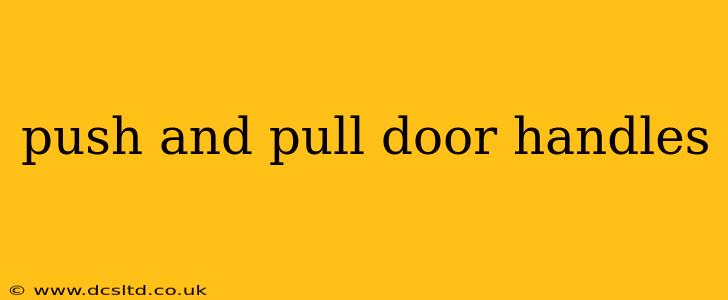Door handles are ubiquitous, yet their design subtly dictates how we interact with buildings and spaces. Understanding the difference between push and pull door handles goes beyond simple aesthetics; it involves considerations of accessibility, safety, and overall design philosophy. This comprehensive guide delves into the nuances of push and pull door handles, exploring their applications, advantages, and disadvantages.
What are Push and Pull Door Handles?
Simply put, push handles require you to push the handle to open the door, while pull handles necessitate pulling the handle to achieve the same outcome. The seemingly minor distinction significantly impacts user experience and the overall functionality of a door.
What are the Differences Between Push and Pull Door Handles?
The core difference lies in the direction of force required to operate the door. Push handles are typically found on doors that open inwards, while pull handles are more common on doors opening outwards. This convention isn't absolute, however, as design choices often supersede strict adherence to this rule.
Aesthetics and Design
Both types offer a wide variety of styles. Push handles can feature sleek, modern designs, often integrated seamlessly into the door's surface. Pull handles, on the other hand, can range from simple, minimalist designs to ornate, traditional styles, often incorporating levers or knobs for added grip and comfort.
Functionality and Ergonomics
Functionality is strongly tied to ergonomics. Push handles are generally easier to use for individuals with limited mobility or strength, as pushing often requires less force than pulling. Pull handles, however, can offer better leverage, particularly on heavy doors.
Accessibility Considerations
Accessibility is a critical factor in choosing between push and pull handles. The Americans with Disabilities Act (ADA) guidelines influence design choices, prioritizing ease of use for people with disabilities. For instance, lever handles are often preferred over knobs due to their ease of operation. However, the optimal handle type depends heavily on the specific context and location of the door.
What Type of Door Handle is Best for Different Settings?
The ideal type of door handle varies considerably depending on the context:
-
Commercial Buildings: Commercial settings often prioritize durability and security. High-traffic areas may benefit from robust push handles that can withstand frequent use.
-
Residential Homes: In residential settings, aesthetic preference often plays a larger role. However, considerations of accessibility and ease of use for all members of the household should still guide the selection process.
-
Exterior Doors: Exterior doors often require handles that are weather-resistant and secure against forced entry. The choice between push and pull might depend on the direction the door opens and the available space.
-
Interior Doors: Interior doors offer more flexibility. Design preferences can be prioritized, along with considerations of the room's style and the occupants' needs.
What are the Advantages and Disadvantages of Each Type?
Push Handles:
Advantages:
- Easier to use for people with limited mobility or strength.
- Can be more hygienic as they avoid direct contact with the hand.
Disadvantages:
- May require more space for the door to swing open.
- Can be less intuitive for some users, particularly those accustomed to pull handles.
Pull Handles:
Advantages:
- Can offer better leverage for opening heavy doors.
- Often provide a more comfortable grip.
Disadvantages:
- May be more challenging for individuals with limited mobility or strength.
- More susceptible to germs and dirt accumulation due to direct hand contact.
Which is Better: Push or Pull?
There is no single "better" option; the optimal choice depends entirely on the specific application. Consider factors such as accessibility needs, the weight of the door, available space, and overall aesthetic preferences. Often, a combination of push and pull handles is used in various locations within a single building to optimize usability.
Frequently Asked Questions (Addressing potential "People Also Ask" queries)
Are push handles easier to open than pull handles?
Generally, push handles require less effort than pull handles, making them more accessible to individuals with limited strength or mobility. However, the ease of use also depends on the door's weight and the design of the handle itself.
Which type of door handle is more hygienic?
Push handles can be considered slightly more hygienic as they reduce direct hand contact with the handle's surface, minimizing the transfer of germs. However, regular cleaning of both push and pull handles is crucial for maintaining hygiene in any setting.
What type of door handle is best for elderly people?
Lever handles or push handles are often recommended for elderly individuals due to their ease of use and reduced force requirements compared to pull handles or knobs.
What is the difference between a push plate and a push handle?
A push plate is a flat, rectangular plate that is pushed to open a door, whereas a push handle is a more three-dimensional handle that is also pushed. Push plates are often simpler and less expensive.
Which type of door handle is more secure?
Security depends more on the locking mechanism than the type of handle (push or pull). However, well-designed and properly installed handles of either type can provide adequate security.
This detailed exploration should provide a solid understanding of the differences between push and pull door handles, empowering you to make informed decisions based on individual needs and contexts. Remember to always prioritize accessibility and safety when selecting door hardware.
